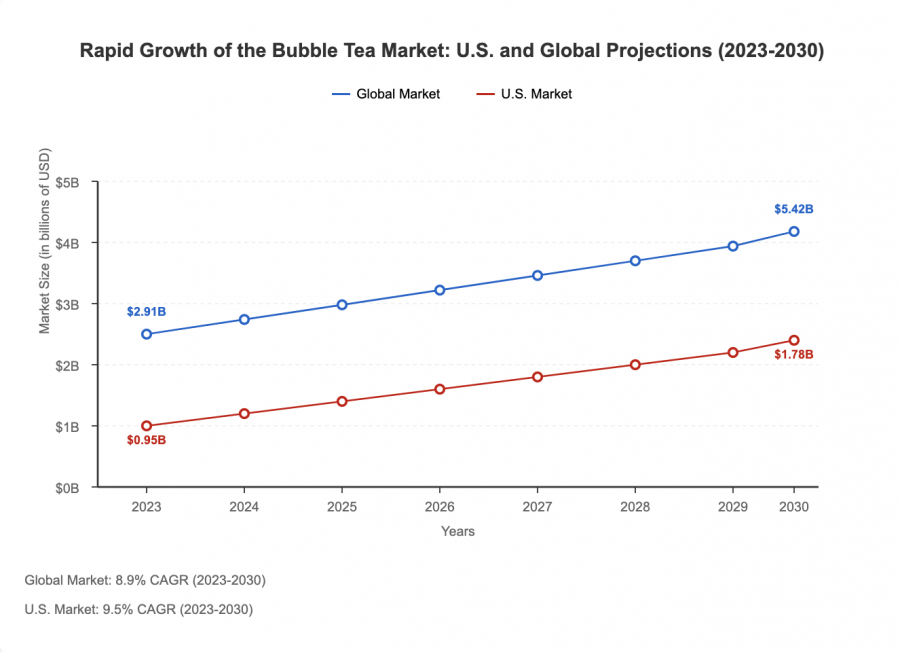© 2025 Bubble Tea Supply. All Rights Reserved.

Key Points
- The U.S. bubble tea market is valued around USD 531.69 million in 2025, growing at about 7.22% annually through 2032.
- Young adults aged 18-34, especially Millennials and Gen Z, are the main consumers, with growing interest across genders and ethnicities.
- Evidence leans toward key trends including customization, health-focused options, sustainability, innovative flavors, and strong social media engagement.
- Business owners can stay updated by following industry reports, engaging customers, and experimenting with new offerings, while promoting health and eco-friendly practices.
Market Overview
The bubble tea market in the U.S. is thriving, with projections indicating a market size of approximately USD 531.69 million in 2025, based on recent industry analyses (U.S. Bubble Tea Market Size, Share & COVID-19 Impact Analysis). This growth, at a compound annual growth rate (CAGR) of 7.22% through 2032, reflects increasing consumer interest in unique, customizable beverages. Globally, the Asia Pacific region dominates with a 43.35% market share, but the U.S. is a fast-growing market, particularly in regions like the Pacific Northwest.
Consumer Insights
Young adults, especially those aged 18-34, are the core consumer base, with 94% of 20-29-year-olds having purchased bubble tea recently, according to surveys (Survey: Millennials, Gen Z Big Fans of Bubble Tea). This group, including Millennials and Gen Z, values social experiences and social media shareable moments, driving demand. While initially popular among Asian Americans, bubble tea is becoming mainstream, with 95% of women and 81% of men under 25 having tried it, showing broad appeal across genders and ethnicities. The most popular flavors include milk tea, Thai milk tea, taro milk tea, and fruit-based options like mango and lychee which are all available at bubbleteasupply.com.
Trends and Opportunities
Key trends include:
- Customization: Offering a variety of flavors, toppings, and sweetness levels caters to individual preferences, enhancing customer satisfaction.
- Health Focus: Low-sugar, low-calorie options with natural ingredients like matcha and chia seeds appeal to health-conscious consumers.
- Sustainability: Eco-friendly packaging, like biodegradable cups, meets growing environmental concerns.
- Innovative Flavors: New tastes, such as brown sugar milk tea and taro, alongside local inspirations, keep menus fresh.
- Social Media: Instagram and TikTok drive visibility, with visually appealing drinks encouraging shares and engagement.
International trends, particularly from Asia, influence the U.S. market, with flavors like Thai milk tea and innovative toppings like colored boba gaining traction. Visit bubbleteasupply.com for wholesale pricing on all your business needs.
Actionable Information for Business Owners
To remain competitive, small business owners should implement the following strategies, balancing cost and innovation:
- Stay Informed: Regularly review industry reports like those from Bubble Tea Supply, attend trade shows such as the World Tea Expo, and follow market leaders on social media to stay updated on trends and consumer preferences.
- Engage with Customers: Use social media polls, customer surveys, and direct interactions to gather feedback. For example, ask customers about preferred flavors or sustainability practices, ensuring offerings align with their needs.
- Menu Innovation: Periodically update your menu with new flavors or limited-time offers, such as seasonal specials (e.g., pumpkin spice milk tea in fall). Start small by testing one new item to gauge interest, minimizing risk.
- Quality Control: Ensure all ingredients, such as high-quality teas and fresh fruits, are sourced reliably to maintain taste and customer trust, enhancing repeat business. Businesses like Bubble Tea Supply have been providing thousands of businesses with the highest quality products since 2001.
- Promote Health and Sustainability: Highlight health benefits (e.g., antioxidants from black tea) and eco-friendly practices (e.g., biodegradable straws) in marketing materials to attract conscious consumers, potentially increasing footfall.
- Collaborate with Influencers: Partner with local food bloggers or TikTok influencers to showcase products, leveraging their reach to attract new customers and build credibility, especially among younger demographics.
These strategies, informed by both U.S. and international trends, can help small businesses adapt and thrive in a competitive market.
Conclusion
The U.S. bubble tea market, valued at approximately USD 531.69 million in 2025 and growing at 7.22% annually, offers significant opportunities for small business owners. With a core consumer base of young adults aged 18-34, particularly Millennials and Gen Z, and trends like customization, health focus, and sustainability shaping demand, businesses must stay
adaptable. By leveraging international insights, such as innovative flavors from Asia and affordability strategies, and implementing practical recommendations like customer engagement and social media marketing, owners can position themselves for success in this dynamic industry.
Key Citations
- U.S. Bubble Tea Market Size, Share & COVID-19 Impact Analysis, By Type, By Flavor, and Regional Forecast, 2025-2032
- U.S. Bubble Tea Market Size, Share & Trends Analysis Report By Type, By Flavor, By Distribution Channel, And Segment Forecasts, 2024 – 2030
- Presentation Trends in Bubble Tea 2025: Where Creativity Meets Flavor
- Bubble Tea Demographics to Know Your Target Market
- Best Selling Bubble Tea Flavors
- Survey: Millennials, Gen Z Big Fans of Bubble Tea
- US Bubble Tea Market Size, Trends, Growth, Analysis & Forecast
- The 10 Best Boba Tea Flavors
- World Tea Expo
- High Quality Bubble Tea Products
© 2025 Bubble Tea Supply. All Rights Reserved.

